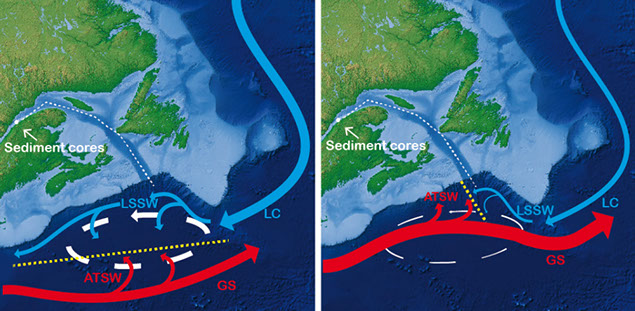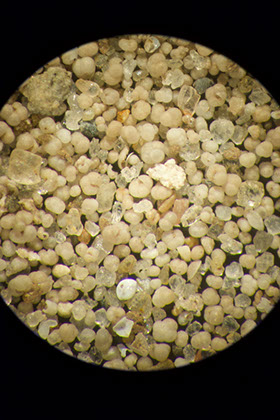The work of Dr Christelle Not and Dr Benoit Thibodeau from the Department of Earth Sciences is focussed on a dramatic weakening of the circulation within the past 100 years, which they believe has been directly caused by global warming and the melting of the Greenland Ice Sheet.
“We have concentrated our research on a sediment core of the Laurentian Channel on the Canadian coast, where two important currents meet,” said Dr Not. “The significant finding is that at this location a warm current has replaced a cold current. It is not a change in the temperature of the water, it is a change in the water that is reaching this location. We interpret this weakening as a direct consequence of global warming, and that it has been driven by climate change in last century.”
Dr Thibodeau added: “This specific change in circulation points towards a major reorganisation of the intermediate currents in the western part of the North Atlantic that is driven by something much larger.”
The currents affected are part of the Atlantic Meridional Overturning Circulation (AMOC), which takes warm surface North Atlantic water from the equator to the sub-polar ocean where cold deep water is formed and returned toward the equator. This change in its strength could affect the climates of North America, Europe, Africa and Asia.
“The discovery of this new record of AMOC will enhance our understanding of its drivers and ultimately help us better comprehend potential near-future change under global warming,”
said Dr Thibodeau. “This warming will have a localised as well as global climatological impact. It is already being felt on the Canadian coast where it has contributed to the formation of a hypoxic zone in which there is not enough oxygen to sustain most marine life. That is already having a tremendous impact on biodiversity, tourism and the local economy.”

![]() This specific change in circulation points towards a major reorganisation of the intermediate currents in the western part of the North Atlantic that is driven by something much larger.
This specific change in circulation points towards a major reorganisation of the intermediate currents in the western part of the North Atlantic that is driven by something much larger. ![]()
Dr Benoit Thibodeau
“We show that the temperature of the water at the coring site is controlled by the strength of the AMOC, which implies that the temperature reconstructed from this core is indicative of one of the most significant drivers of global climate. Discovering a proxy for such an important feature of our climate system is a major step towards a better understanding of that the future climate will be.”
“The novelty of our study is the interpretation and the validation we performed using high-end numerical modelling, which allowed us to prove that our isotopic record of temperature could be used as proxy of the AMOC. No one else has looked at this kind of data using this optic,” explained Dr Thibodeau.
After studying the sediment core, the two scientists then looked for collaborators to further the investigations and validate their results. They worked with scientists from US using numerical models to simulate the climate and the ocean. With these, they recreated currents and could see what would happen, enabling them to connect their local data to a much larger, global phenomenon.
“Modelling helped us validate the hypothesis: it is the weakening of the AMOC that is causing change in temperature,” said Dr Thibodeau. “You can take a core at the end of the St Lawrence and register what is happening in the Atlantic Ocean. We captured the long-term and the short-term variability, and we can see that it is recent conditions of Earth that are effecting the circulation. Physical oceanographers have only been able to quantify the AMOC for a couple of decades. What we bring is a new, much longer perspective.”
There is a lot of debate about the state of the AMOC within the oceanography community, mostly because records only span a couple of decades. This new, high-resolution record of AMOC (each sample represents about two years) over a long period of time will bring a new perspective on the issue and confirm that the decreasing trend now being seen in the instrumental data, despite its variability, is real and significant over the past 1,500 years.
The next step in the research is to go even further back. Pending more funding, Dr Not and Dr Thibodeau would like to analyse the same sediment core but over the last 7,000 years to produce the first complete reconstruction of the AMOC since the inception of the convection in the Labrador Sea about 6,000 to 7,000 years ago.
They are looking at the past to better understand the future. “We will try to locate conditions in
the past that are close to what we expect to happen 30 years from now,” said Dr Thibodeau. “We know the circulation is weakening, the next questions are will that continue, will there be equilibrium, and will it stop?”
Dr Not added: “400,000 years ago the position of the Earth and the Sun were similar to today but temperatures were slightly warmer, similar to what we expect 20 to 30 years from now, so we’re trying to look at circulation then and compare it to today’s circulation. We are looking for similar conditions in Earth’s history and hoping to use this information as an analogue for the future of the ocean.”
First real evidence
Scientists know the AMOC plays an important role in regulating global climate but have
been unable to validate signs of its intensity. While the weakening was predicted by climate modelling, this is the first real piece of evidence that in the past 1,500 years the ocean circulation in the North Atlantic has never been as weak as it is now. Dr Not and Dr Thibodeau were able to estimate past temperatures of the circulation by studying foraminifer, or microfossils, from a sediment core in the Laurentian Channel.
“The microfossils we studied are from small organisms living at the surface of the ocean,” said Dr Not. “When the organisms die, the shell remains and sinks to the bottom of the sediment where they are preserved through time, and so we looked at the chemistry of the shell. During its formation, the isotopic chemistry changes dependingon water temperature.

Circulation Problem
Two scientists are looking at climate change from the perspective of marine geology, and have uncovered evidence that the North Atlantic ocean circulation is weaker than it has been at any time in the past 1,500 years.
Next
Back

Picture of the microfossils used in the study.
Schematics of the circulation in the western North Atlantic during episode of strong (left) and weak (right) westward transport of the Labrador Current (LC).
Home
May 2019
Volume 20
No. 2

Research
